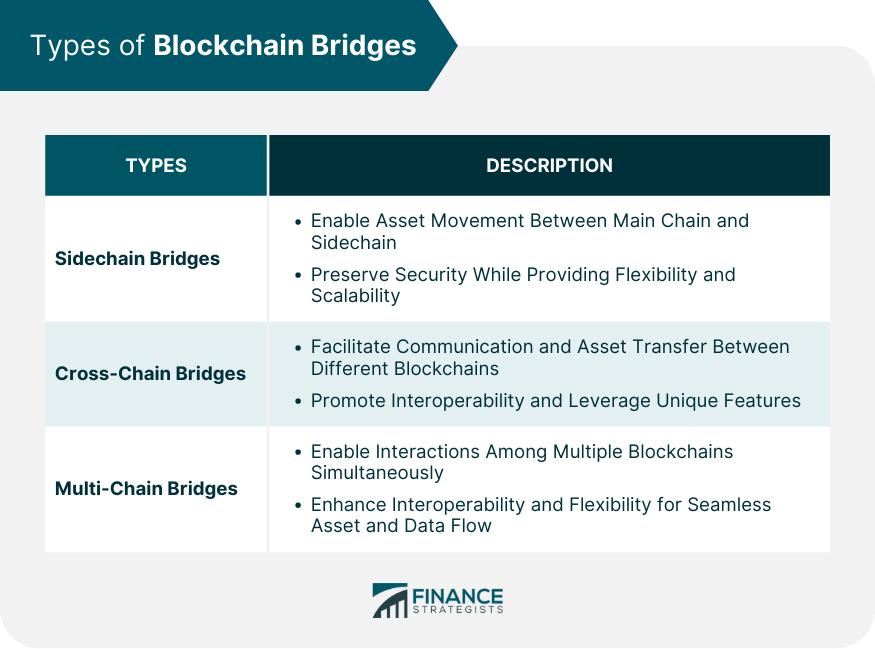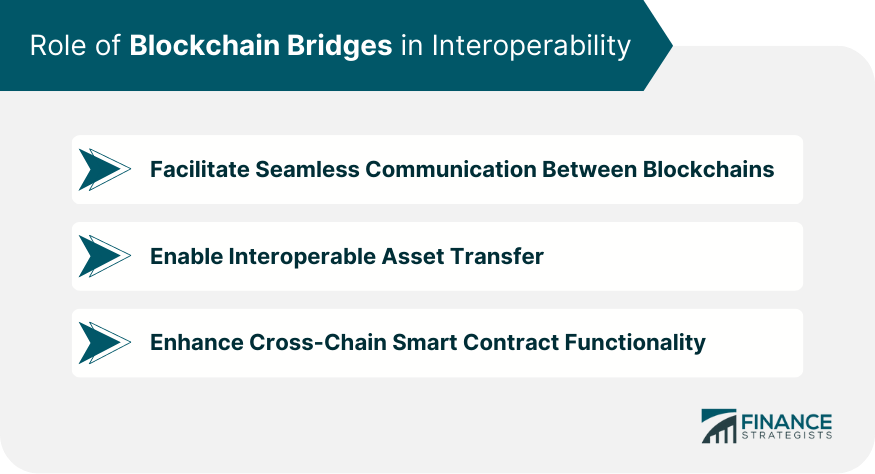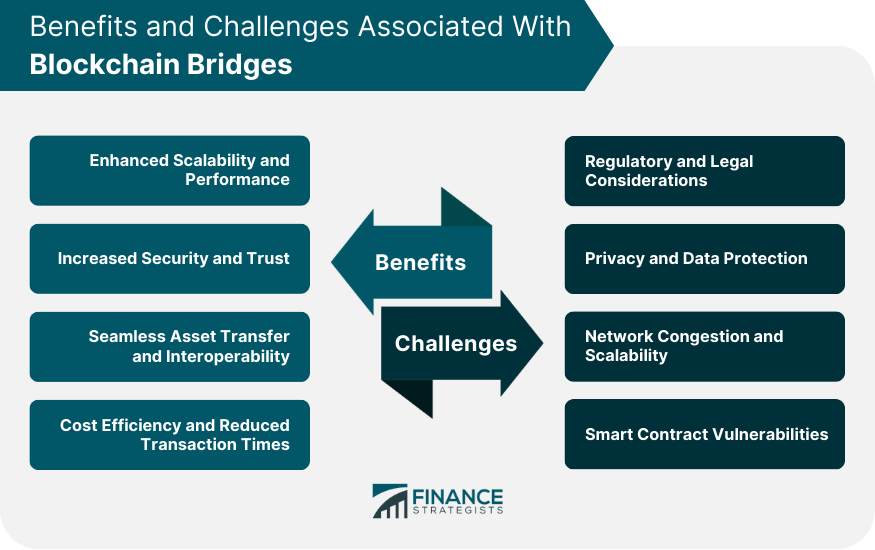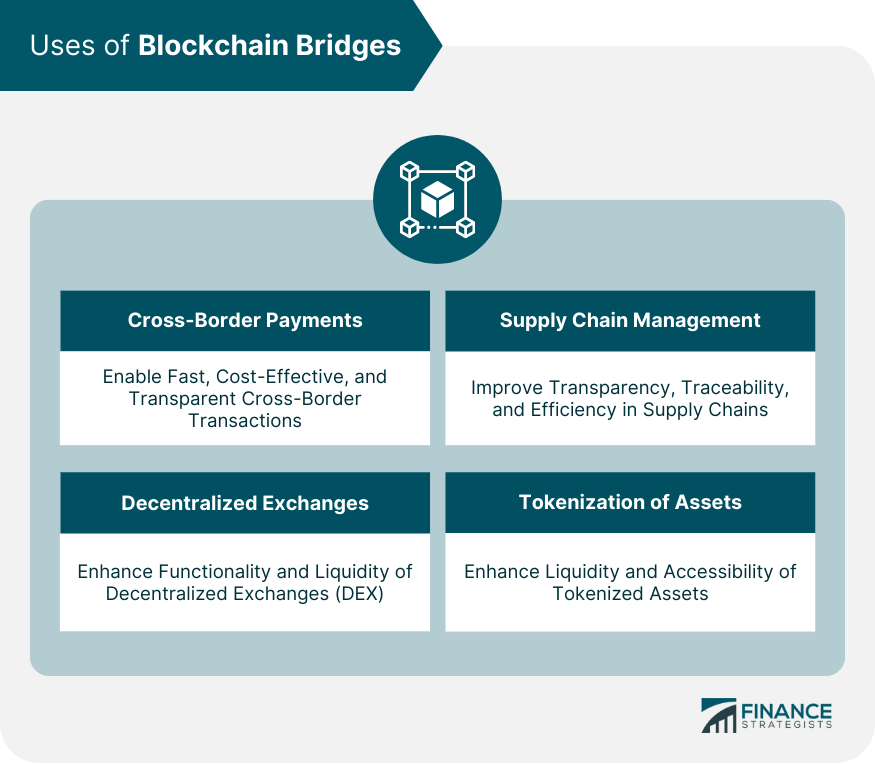Blockchain Bridges are methods or protocols that enable two distinct blockchain ecosystems to communicate and interact with each other. These bridges connect different blockchains allowing them to share information, transfer assets, and communicate seamlessly. In the world of blockchain, where countless distinct ecosystems exist, bridges are crucial. They pave the way for interoperability, eliminating the traditional silos and promoting a more interconnected, efficient blockchain infrastructure. Sidechain bridges represent a specific type of blockchain bridge. These bridges allow assets to move between a main chain and a sidechain - an auxiliary blockchain that runs parallel to the main blockchain. The sidechain operates independently, providing a sandbox-like environment where developers can experiment and implement changes without impacting the main chain's operations. This setup offers increased flexibility and scalability while preserving the security of the main chain. Cross-chain bridges, as the name suggests, facilitate the communication and asset transfer between two different blockchains. This type of bridge is particularly important in the current blockchain landscape, where numerous standalone blockchains exist with their unique protocols and ecosystems. Cross-chain bridges allow these different blockchains to interact, enabling the transfer of data, assets, and other values across chains. This not only improves interoperability but also allows users to benefit from unique features and advantages of different blockchains. Multi-chain bridges take the concept of cross-chain bridges a step further by enabling interactions among multiple blockchains simultaneously. Instead of just connecting two blockchains, multi-chain bridges create a network of interconnected chains. These bridges significantly improve interoperability and flexibility within the blockchain ecosystem. With a multi-chain bridge, assets and data can flow freely among multiple blockchains, expanding possibilities for users and developers alike. In the current blockchain landscape, there are numerous isolated blockchain networks, each with its unique features and protocols. Blockchain bridges act as translators, enabling these networks to understand each other and communicate effectively. This seamless communication is essential for enhancing the overall functionality and efficiency of the blockchain ecosystem. Without these bridges, assets would remain confined to their native blockchain, limiting their utility and liquidity. With blockchain bridges, users can move their assets from one blockchain to another seamlessly. This opens up new possibilities for asset usage and investment, allowing users to take advantage of unique features and opportunities across different blockchains. These digital agreements, programmed to execute automatically when certain conditions are met, are a vital feature of many blockchains. However, without blockchain bridges, a smart contract on one blockchain wouldn't interact with another chain. Blockchain bridges solve this problem, enhancing cross-chain smart contract functionality. This capability allows developers to create more complex, interconnected applications spanning multiple blockchains. By connecting different blockchains and distributing the workload, these bridges can help overcome the limitations of individual blockchains, particularly in terms of transaction speed and capacity. Moreover, blockchain bridges can help mitigate network congestion issues. By allowing transactions to flow across multiple blockchains, these bridges can optimize network performance, enhancing the efficiency of financial operations. Blockchain bridges also contribute to increased security and trust in financial transactions. By enabling interoperability, these bridges allow for comprehensive auditing and monitoring of transactions across different blockchains, ensuring transparency and reducing the risk of fraud. Moreover, blockchain bridges utilize advanced cryptographic techniques to secure transactions and data transfers, further boosting security. This can be particularly important in financial applications where the integrity and security of transactions are paramount. Traditional financial systems often involve multiple intermediaries and lengthy processes for cross-border transactions. Blockchain bridges can streamline this process, allowing assets to be transferred seamlessly across different blockchains. This can not only expedite cross-border transactions but also reduce associated costs, making financial operations more efficient and accessible. Finally, cost efficiency and reduced transaction times are significant benefits of blockchain bridges in finance. By eliminating the need for intermediaries and streamlining asset transfers, blockchain bridges can significantly reduce transaction costs. Moreover, the ability to conduct transactions across multiple blockchains can reduce transaction times, improving the efficiency of financial operations. This can be particularly beneficial in areas like cross-border payments, where traditional transaction methods can be time-consuming and costly. Like any innovative technology, blockchain bridges come with their share of regulatory and legal considerations. Given the global nature of blockchain and the varying regulatory landscape across countries, navigating these complexities can be a challenge. Moreover, the transfer of assets across different blockchains can also raise legal issues, particularly concerning ownership and jurisdiction. Therefore, careful consideration and planning are needed to ensure compliance with all relevant laws and regulations. Privacy and data protection are also significant concerns associated with blockchain bridges. While blockchain technology is inherently secure, the transfer of data across different chains can potentially expose sensitive information. Moreover, the decentralized nature of blockchain can make it difficult to enforce privacy laws and regulations, further complicating matters. Therefore, adequate measures, such as encryption and anonymization techniques, should be employed to ensure privacy and data protection. As these bridges facilitate the movement of assets and data across multiple blockchains, they can potentially overload the network, affecting transaction speeds and performance. Therefore, it's essential to implement proper management and optimization strategies when using blockchain bridges, to ensure that the network can handle the increased workload effectively. Smart contracts are a crucial component of many blockchain bridges. However, they can also pose potential security risks. If not properly designed and audited, smart contracts can contain vulnerabilities that malicious actors can exploit. These vulnerabilities can not only compromise the security of transactions but also lead to significant financial losses. Therefore, thorough testing and auditing of smart contracts are crucial when using blockchain bridges. Traditional cross-border payment systems are often slow, costly, and lack transparency. Blockchain bridges can help overcome these issues, enabling fast, cost-effective, and transparent cross-border transactions. By allowing assets to move seamlessly across different blockchains, these bridges can streamline cross-border payments, reducing transaction times and costs. This can be particularly beneficial for businesses and individuals engaged in international trade and transactions. Decentralized exchanges (DEX) represent another area where blockchain bridges can be highly beneficial. DEXs allow users to trade cryptocurrencies directly with each other, without the need for an intermediary. However, the isolated nature of different blockchains can limit the functionality and liquidity of DEXs. Blockchain bridges can solve this issue, connecting different blockchains and enabling seamless asset transfer. This can greatly enhance the functionality and liquidity of DEXs, making them more efficient and user-friendly. Supply chain management is another area where blockchain bridges can be highly beneficial. Blockchain technology can provide increased transparency, traceability, and efficiency in supply chains. However, the isolated nature of different blockchains can limit these benefits. Blockchain bridges can solve this issue, connecting different blockchains involved in a supply chain and enabling seamless data and asset transfer. This can enhance supply chain transparency, traceability, and efficiency, benefiting all stakeholders involved. Tokenization involves representing real-world assets on the blockchain, providing increased liquidity, accessibility, and efficiency. However, the isolated nature of different blockchains can limit the benefits of tokenization. Blockchain bridges can solve this issue, enabling tokens to move seamlessly across different blockchains. This can enhance the liquidity and accessibility of tokenized assets, opening up new opportunities for investment and trade. Blockchain bridges are crucial methods or protocols that facilitate seamless communication and interaction between distinct blockchain ecosystems. These bridges connect different blockchains, enabling them to share information, transfer assets, and communicate effectively. Blockchain bridges play a pivotal role in enhancing scalability, improving security and trust in financial transactions, enabling seamless asset transfer and interoperability, and reducing costs and transaction times. They facilitate comprehensive auditing, optimize network performance, streamline cross-border payments, empower decentralized exchanges, enhance supply chain management, and increase the liquidity and accessibility of tokenized assets. Despite challenges such as regulatory considerations, privacy concerns, network congestion, and smart contract vulnerabilities, embracing blockchain bridges holds immense potential for revolutionizing the finance industry. What Are Blockchain Bridges?
Types of Blockchain Bridges
Sidechain Bridges
Cross-Chain Bridges
Multi-Chain Bridges

Role of Blockchain Bridges in Interoperability
Facilitating Seamless Communication Between Blockchains
Enabling Interoperable Asset Transfer
Enhancing Cross-Chain Smart Contract Functionality

Benefits of Blockchain Bridges in Finance
Enhanced Scalability and Performance
Increased Security and Trust
Seamless Asset Transfer and Interoperability
Cost Efficiency and Reduced Transaction Times
Challenges Associated With Blockchain Bridges
Regulatory and Legal Considerations
Privacy and Data Protection
Network Congestion and Scalability
Smart Contract Vulnerabilities

Uses of Blockchain Bridges
Cross-Border Payments
Decentralized Exchanges (DEX)
Supply Chain Management
Tokenization of Assets

Conclusion
Blockchain Bridges FAQs
A blockchain bridge is a method or protocol that enables two distinct blockchain ecosystems to communicate and interact with each other. It allows for seamless communication, data transfer, and asset transfer across different blockchains.
There are three main types of blockchain bridges: sidechain bridges, cross-chain bridges, and multi-chain bridges. These bridges vary in terms of their functionality and the number of blockchains they can connect.
Blockchain bridges can enhance scalability and performance, increase security and trust, allow for seamless asset transfer and interoperability, and reduce transaction times and costs in finance.
Some of the main challenges associated with blockchain bridges include regulatory and legal considerations, privacy and data protection issues, network congestion and scalability issues, and smart contract vulnerabilities.
Some of the key uses of blockchain bridges include facilitating cross-border payments, enhancing the functionality and liquidity of decentralized exchanges (DEX), improving supply chain management, and enabling the tokenization of assets.
True Tamplin is a published author, public speaker, CEO of UpDigital, and founder of Finance Strategists.
True is a Certified Educator in Personal Finance (CEPF®), author of The Handy Financial Ratios Guide, a member of the Society for Advancing Business Editing and Writing, contributes to his financial education site, Finance Strategists, and has spoken to various financial communities such as the CFA Institute, as well as university students like his Alma mater, Biola University, where he received a bachelor of science in business and data analytics.
To learn more about True, visit his personal website or view his author profiles on Amazon, Nasdaq and Forbes.















